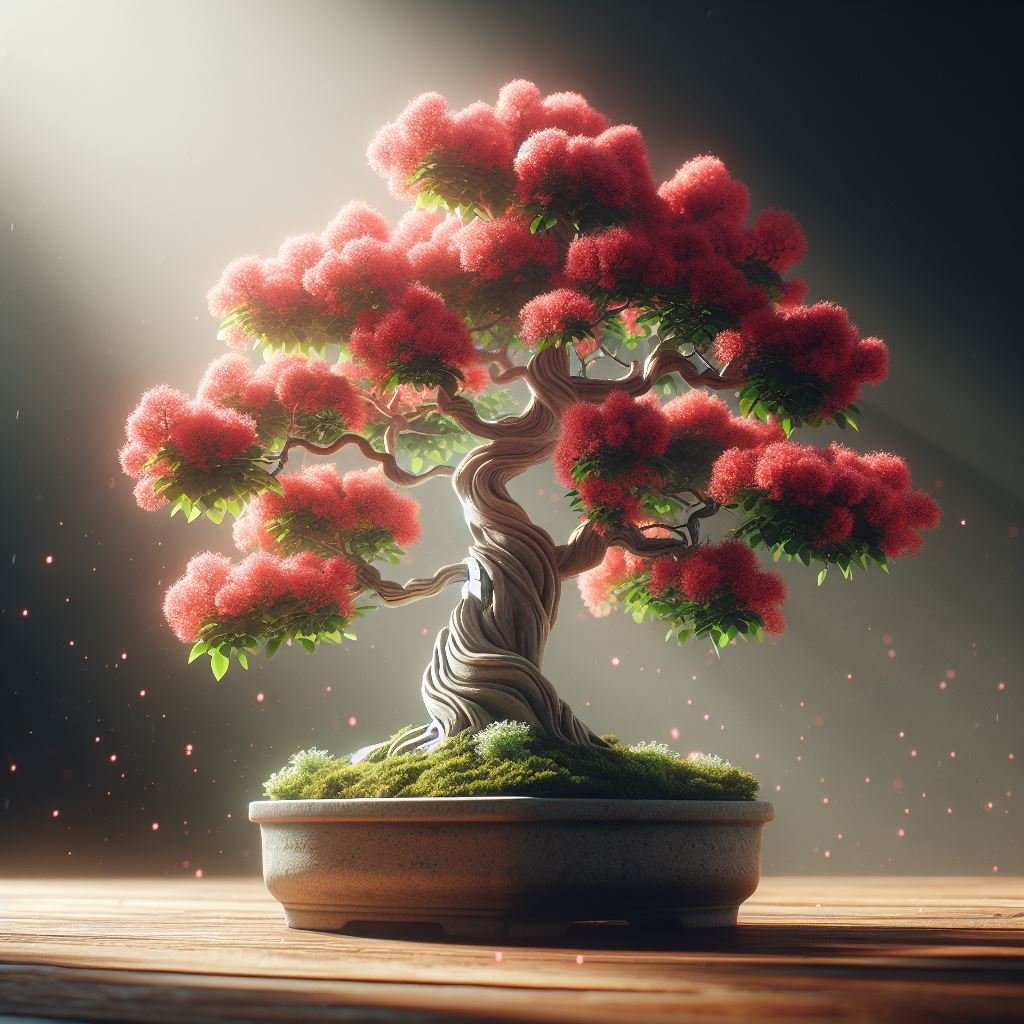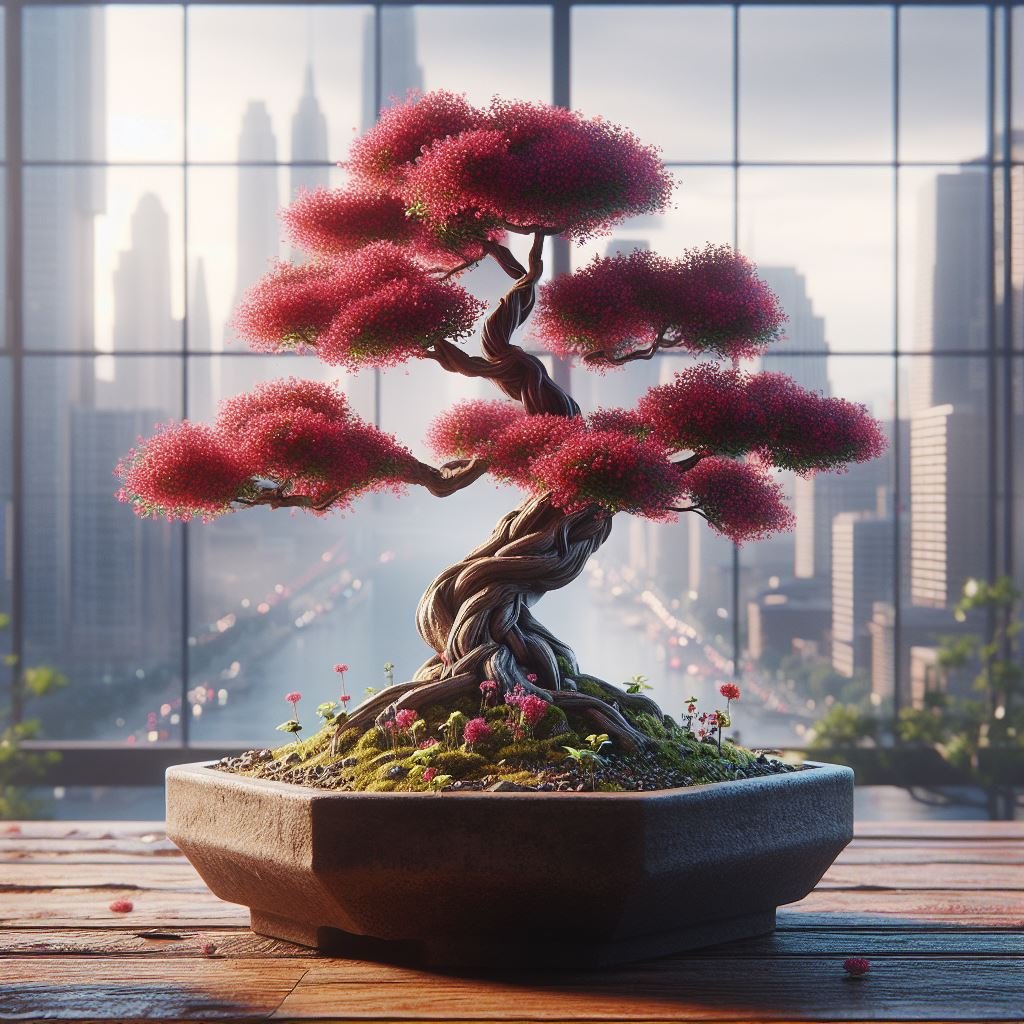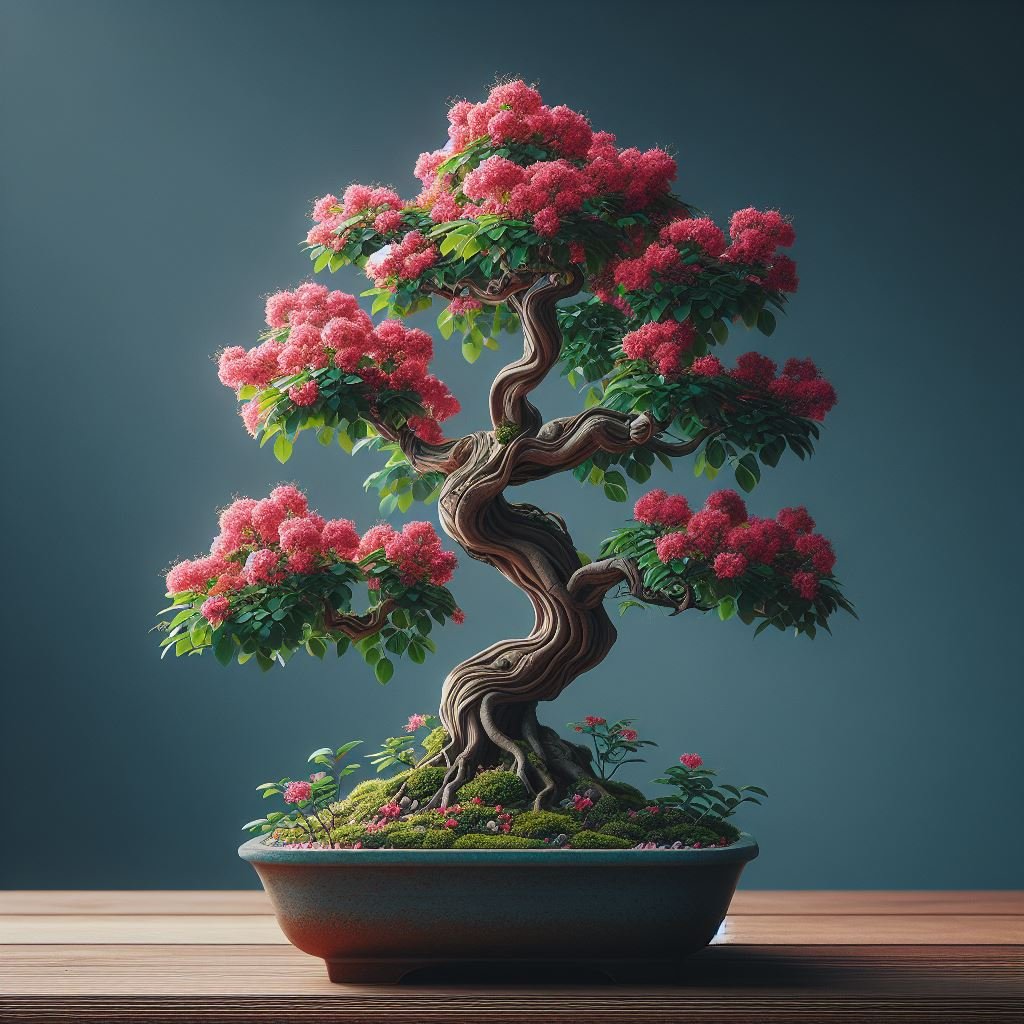Discover the world of Crepe Myrtle Bonsai, a subtropical deciduous tree that is transforming miniature gardening with its vibrant blossoms and unique charm. With its beautiful pink, white, or purple flowers and smooth beige dappled peeling bark, this bonsai species brings a touch of elegance to any setting. Whether you’re a seasoned bonsai enthusiast or just beginning your journey, the Crepe Myrtle Bonsai offers a rewarding and captivating experience.
Introduction to Crepe Myrtle Bonsai

Origin and Characteristics
Crepe Myrtle, or Lagerstroemia, is a genus of around 50 species of deciduous and evergreen trees native to the Indian subcontinent, Southeast Asia, Northern Australia, and parts of Oceania. They are known for their showy summer blossoms that come in a range of colors from white to deep red. When it comes to bonsai, Crepe Myrtle makes an excellent choice due to its small leaves, attractive bark, and stunning flowers. The tree’s natural ability to withstand pruning and shaping further contributes to its popularity among bonsai enthusiasts.
Varieties: Dwarf and Miniature Crepe Myrtle
The Crepe Myrtle family features a variety of species suitable for bonsai, including several dwarf and miniature varieties. Dwarf Crepe Myrtles typically grow between 3 to 6 feet tall, making them ideal for small gardens or indoor cultivation. These varieties often produce abundant clusters of vibrant flowers, creating a stunning visual impact. Miniature Crepe Myrtles, on the other hand, usually don’t exceed 3 feet in height. Despite their small size, they offer all the charm of their larger counterparts, including the signature smooth, peeling bark, and colorful blooms.
Cultivating Crepe Myrtle Bonsai

Ideal Conditions for Growth
Crepe Myrtle Bonsai thrives best in a warm, sunny environment. They prefer well-draining soil and require regular watering, especially during the growing season. A balanced fertilizer can be used throughout the growing season to promote healthy growth and flowering.
The Importance of Light and Air
Light is crucial for Crepe Myrtle Bonsai as it directly impacts its growth and flowering. Place your bonsai in a location where it can receive at least 5-6 hours of sunlight daily. However, protect it from the intense afternoon sun which may cause leaf burn. Adequate airflow is also vital for the health of the tree, helping to prevent diseases and encouraging good growth.
Seasonal Care Tips: Spring, Summer, Autumn
Spring: This is the time for repotting Crepe Myrtle Bonsai. After repotting, place the tree in a shaded area for a few weeks to allow it to recover. Begin fertilizing once new growth appears.
Summer: Water frequently as Crepe Myrtles are thirsty trees during the hot summer months. You can also start pruning after the tree has flowered to maintain its shape.
Autumn: Reduce watering as the temperature starts to drop. Prepare the tree for the winter by moving it indoors if you live in a region with harsh winters. The tree can tolerate cool temperatures but must be protected from freezing conditions.
Remember, each tree is unique and may not follow a strict schedule. Always observe your bonsai’s health and react accordingly.
The Aesthetics of Crepe Myrtle Bonsai
Flowering Patterns and Colors
Crepe Myrtle Bonsai is renowned for its spectacular summer blooms. The tree produces clusters of delicate, crepe-paper-like flowers in a variety of colors, including white, pink, red, and purple. The flowering pattern is often profuse, covering the entire tree and creating a stunning visual display that can last for several weeks.
Unique Stem and Bark Features
Beyond their vibrant blooms, Crepe Myrtles also stand out for their unique stem and bark characteristics. The bark is smooth and peels away in thin flakes, revealing a mottled pattern of grey, brown, and pink underneath. This feature gives the tree an aged appearance, adding to its appeal as a bonsai specimen. The branches and stems are flexible and resilient, making them ideal for various bonsai styling techniques.
Changing Foliage in Fall
In autumn, the leaves of the Crepe Myrtle Bonsai transform into beautiful shades of yellow, orange, and red, adding another layer of interest to this already captivating tree. This changing foliage, combined with the distinctive bark and the potential for late-season blooms, makes the Crepe Myrtle Bonsai a standout choice for those seeking year-round beauty in their miniature gardens.
Practical Tips for Growing Crepe Myrtle Bonsai

Propagation Methods
Crepe Myrtle Bonsai can be propagated through seeds, cuttings, and air layering. However, the most common method is propagation from cuttings. Take a 4-6 inch cutting from a healthy branch during the summer months, remove the lower leaves, and place it in a pot with well-draining soil. Keep the soil moist until the cutting has rooted, which usually takes a few weeks.
Pruning and Shaping Techniques
Pruning is essential for maintaining the shape and size of your Crepe Myrtle Bonsai. Regular trimming encourages branching and keeps the tree compact. Major pruning should be done during late winter or early spring when the tree is dormant. Wire can be used to shape the branches, but care should be taken not to damage the bark.
Pest and Disease Management
Crepe Myrtle Bonsai is relatively resistant to pests, but it can occasionally suffer from aphids, scales, and powdery mildew. Regular inspection of your tree can help catch these issues early. If detected, use a gentle insecticidal soap or a suitable fungicide for treatment. Remember to ensure good ventilation around your bonsai to prevent fungal diseases. Also, avoid overwatering as it can lead to root rot.
Showcase of Crepe Myrtle Bonsai Specimens
Crepe Myrtle Bonsai is a favorite among many bonsai enthusiasts due to its vibrant blooms and distinctive bark. Various growers have showcased their unique Crepe Myrtle Bonsai specimens.
For instance, Greenwood Bonsai featured a video of Corin trimming a unique Crepe Myrtle Bonsai tree. Adam’s Art and Bonsai Blog also shared a progression of a specimen Crepe Myrtle, demonstrating how it evolved over time.
GNO Bonsai Society discussed the development of a Crepe Myrtle Bonsai, particularly highlighting the dwarf and miniature varieties. Nate’s Nursery provided an example of a harmonious design with a White Crape Myrtle.
Use in Fairy Gardens and Other Settings
Crepe Myrtle Bonsai trees aren’t just limited to traditional bonsai displays. Their miniature size and vibrant colors make them perfect for use in fairy gardens, terrariums, and other imaginative settings. For instance, on Pinterest, there are numerous examples of Miniature Crape Myrtles transformed into striking Bonsai specimens. They provide a whimsical touch and a splash of color that can bring any tiny garden scene to life.
Whether you’re an experienced bonsai grower or a beginner, Crepe Myrtle Bonsai offers an exciting opportunity to create a living work of art.
Footnotes
- Greenwood Bonsai – YouTube ↩
- Specimen Crepe Myrtle progression – Adam’s Art and Bonsai Blog ↩
- Developing a Crepe Myrtle Bonsai – GNO Bonsai Society ↩
- Design and Critique #6 – Crape Myrtle ‘Natchez’ – Nate’s Nursery ↩
- Pin on Bonsai Wee Trees – Pinterest ↩
Conclusion: The Joy of Growing Crepe Myrtle Bonsai
Growing Crepe Myrtle Bonsai can be a rewarding journey, one that combines the joys of gardening with the satisfaction of creating a living work of art. It is a process that requires patience, attention, and care, but the payoff is well worth it. The vibrant blooms, the unique bark, and the changing foliage all add to the aesthetic appeal of this tree.
Moreover, cultivating a bonsai is more than just a hobby—it’s a form of meditation, a way to connect with nature on a deeper level. Every time you prune your tree or water it, you’re not just maintaining a plant; you’re nurturing a relationship with a tiny piece of the natural world.
Resources for Further Learning and Supplies
If you’re interested in growing your own Crepe Myrtle Bonsai, there are numerous resources available to help you get started. Books like “Bonsai: A Beginners Guide” by Bonsai Empire and “The Complete Book of Bonsai” by Harry Tomlinson offer comprehensive guides to the art of bonsai cultivation.
Online forums like Bonsai Nut and Bonsai Empire Forum provide a platform for beginners and experts alike to share tips and experiences. For supplies, you can check out online stores like Bonsai Boy, Eastern Leaf, and Brussel’s Bonsai.
Whether you’re an experienced bonsai enthusiast or a curious beginner, the Crepe Myrtle Bonsai offers an exciting opportunity to engage with nature in a meaningful and creative way.
Footnotes
- “Bonsai: A Beginners Guide” – Bonsai Empire ↩
- “The Complete Book of Bonsai” – Harry Tomlinson ↩
- Bonsai Nut Forum ↩
- Bonsai Empire Forum ↩
- Bonsai Boy ↩
- Eastern Leaf ↩
- Brussel’s Bonsai ↩
Frequently Asked Questions (FAQs)
What is the best time to prune a Crepe Myrtle Bonsai?
The best time to prune a Crepe Myrtle Bonsai is during late winter or early spring when the tree is dormant. This allows the tree to recover and grow new branches in the coming growing season.
How do I protect my Crepe Myrtle Bonsai from pests and diseases?
Regular inspection of your Crepe Myrtle Bonsai can help detect pests like aphids and scales, and diseases like powdery mildew early. If detected, use a gentle insecticidal soap or a suitable fungicide for treatment. Adequate ventilation around your bonsai can help prevent fungal diseases and avoid overwatering to prevent root rot.
Where can I find inspiration for my Crepe Myrtle Bonsai?
Various bonsai enthusiasts and societies showcase their unique Crepe Myrtle Bonsai specimens online. You can find inspiration in the work of Greenwood Bonsai, Adam’s Art and Bonsai Blog, GNO Bonsai Society, and Nate’s Nursery, among others.
Can Crepe Myrtle Bonsai be used in other settings besides traditional bonsai display?
Yes, Crepe Myrtle Bonsai’s miniature size and vibrant colors make them perfect for use in fairy gardens, terrariums, and other imaginative settings.
Where can I learn more about growing a Crepe Myrtle Bonsai?
Books like “Bonsai: A Beginners Guide” by Bonsai Empire and “The Complete Book of Bonsai” by Harry Tomlinson offer comprehensive guides. Online forums like Bonsai Nut and Bonsai Empire Forum are also excellent resources.






You’re so awesome! I don’t believe I have read a single thing like that before. So great to find someone with some original thoughts on this topic. Really.. thank you for starting this up. This website is something that is needed on the internet, someone with a little originality!
Thank you so much for your kind words! I’m here to provide helpful and original content, and I’m really glad you find it valuable. Your encouragement is greatly appreciated and fuels my desire to continue delivering quality information. Thanks again for your support!